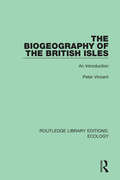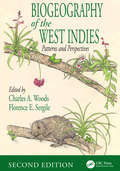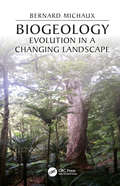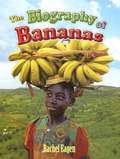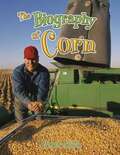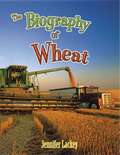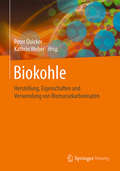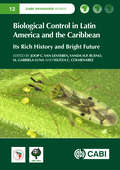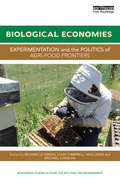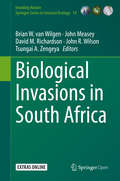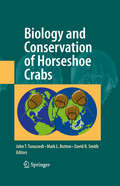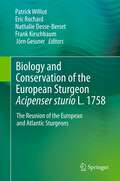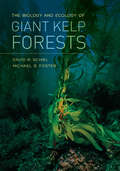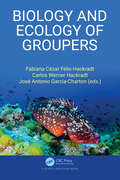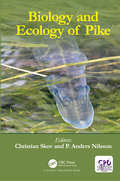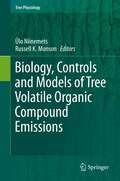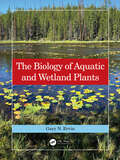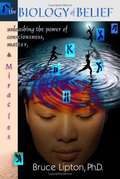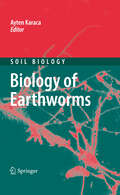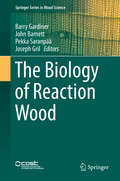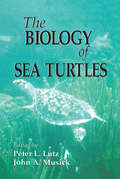- Table View
- List View
Biogeography of Australasia
by Michael HeadsOver the last decade, molecular studies carried out on the Australasian biota have revealed a new world of organic structure that exists from submicroscopic to continental scale. Furthermore, in studies of global biogeography and evolution, DNA sequencing has shown that many large groups, such as flowering plants, passerine birds and squamates, have their basal components in this area. Using examples ranging from kangaroos and platypuses to kiwis and birds of paradise, the book examines the patterns of distribution and evolution of Australasian biodiversity and explains them with reference to tectonic and climatic change in the region. The surprising results from molecular biogeography demonstrate that an understanding of evolution in Australasia is essential for understanding the development of modern life on Earth. A milestone in the literature on this subject, this book will be a valuable source of reference for students and researchers in biogeography, biodiversity, ecology and conservation.
The Biogeography of the British Isles: An Introduction (Routledge Library Editions: Ecology #17)
by Peter VincentOriginally published in 1990, The Biogeography of the British Isles is devoted to the biogeography of the British Isles and surrounding shelf seas. Bringing together a wealth of diverse information, it is thoroughly referenced and well illustrated, and will be invaluable to students of geography, environmental science, ecology, botany, and zoology. The book traces the development of British biogeography over the last two centuries, examining key topics such as ecosystems, habitats, and niches in the context of plant and animal distribution. The book gives a detailed account of the development of biogeographical mapping and recording systems, and describes modern-day distributions, both in the countryside and in urban areas against the backcloth of human activities.
Biogeography of the West Indies: Patterns and Perspectives, Second Edition
by Charles A. Woods Florence E. SergileAs a review of the status of biogeography in the West Indies in the 1980s, the first edition of Biogeography of the West Indies: Past, Present, and Future provided a synthesis of our current knowledge of the systematics and distribution of major plant and animal groups in the Caribbean basin. The totally new and revised Second Edition, Biogeography
Biogeology: Evolution in a Changing Landscape (CRC Biogeography Series)
by Bernard MichauxThis detailed exposition gives background and context to how modern biogeography has got to where it is now. For biogeographers and other researchers interested in biodiversity and the evolution of life on islands, Biogeology: Evolution in a Changing Landscape provides an overview of a large swathe of the globe encompassing Wallacea and the western Pacific. The book contains the full text of the original article explored in each chapter, presented as it appeared on publication. Key features: Holistic treatment, collecting together a series of important biogeographical papers into a single volume Authored by an expert who has spent nearly three decades actively involved in biogeography Describes and interprets a region of exceptional biodiversity and extreme endemism The only book to provide an integrated treatment of Wallacea, Melanesia, New Zealand, the New Zealand Subantarctic Islands and Antarctica Offers a critique of fashionable neo-dispersalist arguments, showing how these still suffer from the same weaknesses of the original Darwinian formulation. The chapters also include analysis of many major theoretical and philosophical issues of modern biogeographic theory, so that those interested in a more philosophical approach will find the book stimulating and thought-provoking.
The Biography of Bananas (How Did That Get Here)
by Rachel EagenAlmost unknown in North America before the 1870s, bananas quickly became a popular fruit with a rough history. It was explained who grows your bananas, how they are harvested, and why the banana may soon become extinct.
The Biography of Corn (How Did That Get Here?)
by L. Michelle Nielsen L. Michelle NielsonMaize, or com, was the staple food of many early cultures in South America, Mesoamerica, and the Caribbean. <p><p>The Biography of Corn will teach young readers how the farming of corn spread to the rest of the world and how corn may be one answer to today's problem of fossil fuel consumption.
The Biography of Wheat (How Did That Get Here?)
by Jennifer LackeyThe growing of wheat as a staple food source made permanent settlements possible, particularly for settlers moving West. In this fascinating new book, children will learn how one of the world's most important food crops is grown, harvested, sold, and processed.
Biokohle: Herstellung, Eigenschaften und Verwendung von Biomassekarbonisaten
by Dennis Blöhse Thomas Echterhof Sabrina Eichenauer Simone Heger Claudia Kammann Andrea Kruse Peter Quicker Marc-André Schulten Christoph Sager Saulo Seabra Klaus Serfass Ernst Stadlbauer Kathrin WeberBiomassekarbonisate (Biokohlen) besitzen signifikant unterschiedliche Eigenschaften, die von den Herstellungsverfahren, Prozessbedingungen und Ausgangssubstraten abhängen. Im Buch sind die technisch verfügbaren Verfahren zur Erzeugung von Biokohle beschrieben und die thermochemischen Prozesse erörtert. Anhand von zahlreichen farbigen Abbildungen sind die Prozesse, Eigenschaften und Einsatzmöglichkeiten veranschaulicht. Der Fokus des Buches liegt auf den großtechnischen Anwendungen als Energieträger, als Reduktions- oder Aufkohlungsmittel in metallurgischen Verfahren, in Recyclingprozessen oder in Kraft- und Zementwerken. Aber auch die Anwendung von Biomassekarbonisaten in der Landwirtschaft als Bodenhilfsstoff oder in der Tierhaltung ist aufgezeigt.
Biokunststoffe unter dem Blickwinkel der Nachhaltigkeit und Kommunikation: Status quo, Möglichkeiten und Herausforderungen
by Hans-Josef Endres Marina Mudersbach Hannah Behnsen Sebastian SpierlingDas Buch zeigt, wie eine Nachhaltigkeitsbewertung von Biokunststoffen gelingen kann und wie die Ergebnisse einer solchen Bewertung ausfallen. Es analysiert die öffentliche Wahrnehmung beim Verbraucher sowie die politischen Rahmenbedingungen von Biokunststoffen.
Biological Control in Latin America and the Caribbean: Its Rich History and Bright Future (CABI Invasives Series)
by Hugo César Arredondo-Bernal Jorge L. Sifontes Anobel Barba Lorena Barra-Bucarei César Basso Wagner Bettiol Fermin Blanco Helga Blanco-Metzler Claudia Carolina Antúnez Guillermo Cabrera Walsh Carmen C. Castillo Charlotte E. Causton Ronald D. CaveThe book summarizes the history of biological control in Latin America and the Caribbean. Few publications provide historical detail and the records are, therefore, fragmented until now. By bringing information together in this book, we offer a more complete picture of important developments in biological control on this continent. There are a wealth of text, tables and references about the history of such projects, and which were successful and which failed. This will help plan future biocontrol projects. An overview is provided of the current situation in biological control for many Latin American and Caribbean countries, revealing an astonishing level of practical biological control applied in the region, making it the largest area under biological control worldwide. The final part describes new developments and speculates about the future of biological control in Latin America and the Caribbean.
Biological Economies: Experimentation and the politics of agri-food frontiers (Routledge Studies in Food, Society and the Environment)
by Michael Carolan Hugh Campbell Nick Lewis Richard Le HeronRecent agri-food studies, including commodity systems, the political economy of agriculture, regional development, and wider examinations of the rural dimension in economic geography and rural sociology have been confronted by three challenges. These can be summarized as: ‘more than human’ approaches to economic life; a ‘post-structural political economy’ of food and agriculture; and calls for more ‘enactive’, performative research approaches. This volume describes the genealogy of such approaches, drawing on the reflective insights of more than five years of international engagement and research. It demonstrates the kinds of new work being generated under these approaches and provides a means for exploring how they should be all understood as part of the same broader need to review theory and methods in the study of food, agriculture, rural development and economic geography. This radical collective approach is elaborated as the Biological Economies approach. The authors break out from traditional categories of analysis, reconceptualising materialities, and reframing economic assemblages as biological economies, based on the notion of all research being enactive or performative.
Biological Invasions in South Africa (Invading Nature - Springer Series in Invasion Ecology #14)
by David M. Richardson John R. Wilson Brian W. van Wilgen John Measey Tsungai A. ZengeyaThis open access volume presents a comprehensive account of all aspects of biological invasions in South Africa, where research has been conducted over more than three decades, and where bold initiatives have been implemented in attempts to control invasions and to reduce their ecological, economic and social effects. It covers a broad range of themes, including history, policy development and implementation, the status of invasions of animals and plants in terrestrial, marine and freshwater environments, the development of a robust ecological theory around biological invasions, the effectiveness of management interventions, and scenarios for the future. The South African situation stands out because of the remarkable diversity of the country, and the wide range of problems encountered in its varied ecosystems, which has resulted in a disproportionate investment into both research and management. The South African experience holds many lessons for other parts of the world, and this book should be of immense value to researchers, students, managers, and policy-makers who deal with biological invasions and ecosystem management and conservation in most other regions.
Biologie des Geistesblitzes - Speed up your mind!
by Henning BeckDenken Sie, das Gehirn ist eine perfekte Rechenmaschine, die evolutionäre Krone aller Informationssysteme, die komplexeste Struktur des Universums, präziser und leistungsfähiger als jeder Computer? Vergessen Sie das sofort! Das Gehirn ist ein Haufen voller eitler, fauler und selbstverliebter Zellen, die sich ständig verrechnen und dabei noch permanent von ihren Nachbarn abgelenkt werden. Da hält man es kaum für möglich und doch geschieht das Wunder: Das Gehirn funktioniert! Sehr gut sogar, denn Menschen sind im Gegensatz zu rechnenden Maschinen ausgesprochen kreativ. "Wie das?", mag man fragen und dieses Buch gibt die Antwort darauf. Fachlich fundiert und locker aufbereitet berichtet der deutsche Science Slam-Meister 2012 Henning Beck über das Zusammenspiel von Nerven- und ihren Helferzellen, erklärt, was ein Geistesblitz überhaupt ist, wie er entsteht und was die Hirnforschung zum Thema Kreativität zu sagen hat.
Biology and Conservation of Horseshoe Crabs
by David Smith Mark L. Botton John T. TanacrediThe four living species of horseshoe crabs face a set of growing threats to their survival, including the erosion and/or man-made alteration of essential spawning habitat, coastal pollution, and overfishing. Horseshoe crabs are "living fossils", with a more than 200 million year evolutionary history. Their blood provides a reagent, known as Limulus amebocyte lysate or LAL, that clots in the presence of minute quantities of bacterial endotoxin; the LAL test is the state-of-the-art methodology used to ensure that pharmaceuticals and surgical implants are free of contamination. Horseshoe crabs are an integral part of the food web in coastal marine ecosystems, and their eggs provide essential food for shorebirds in the Delaware Bay estuary each spring. The commercial fishery for horseshoe crabs, which utilizes animals for bait, contributes to the economies of coastal communities. This book consists of papers presented at the 2007 International Symposium on the Science and Conservation of Horseshoe Crabs.
Biology and Conservation of the European Sturgeon Acipenser sturio L. 1758: The Reunion of the European and Atlantic Sturgeons
by Eric Rochard Frank Kirschbaum Jörn Gessner Nathalie Desse-Berset Patrick WilliotThe book aims at synthesizing our current knowledge of Acipenser sturio and its management. This species, one of the most widespread sturgeon species all over Western Europe ranging from the Black Sea to the Baltic, is now on the verge of extinction. Major aspects of its biology and management, including mismanagement, are provided in a historic perspective. Similarly, the changes in the restoration programs (in situ and ex situ) initiated in France and Germany are presented. As the species occurred in sympatry with Acipenser oxyrinchus in Germany and Poland and very recently in France as well, a brief outlook on restoration-management programs of A. oxyrinchus are also provided for both North America and Northern European countries, namely Germany and Poland. As conservation-restoration actions go beyond scientific issues, non-governmental stakeholders and marine professional fishermen's organizations have also been asked to contribute, and the key role of a French-German cooperation plan is underlined. A part of the book is devoted to perspectives. Illustrations of the European sturgeon, mainly in photographs, but also in stamps and paintings, are presented.
The Biology and Ecology of Giant Kelp Forests
by Michael S. Foster David R. SchielThe largest seaweed, giant kelp (Macrocystis) is the fastest growing and most prolific of all plants found on earth. Growing from the seafloor and extending along the ocean surface in lush canopies, giant kelp provides an extensive vertical habitat in a largely two-dimensional seascape. It is the foundation for one of the most species-rich, productive, and widely distributed ecological communities in the world. Schiel and Foster's scholarly review and synthesis take the reader from Darwin's early observations to contemporary research, providing a historical perspective for the modern understanding of giant kelp evolution, biogeography, biology, and physiology. The authors furnish a comprehensive discussion of kelp species and forest ecology worldwide, with considerations of human uses and abuses, management and conservation, and the current and likely future impacts of global change. This volume promises to be the definitive treatise and reference on giant kelp and its forests for many years, and it will appeal to marine scientists and others who want a better appreciation and understanding of these wondrous forests of the sea.
Biology and Ecology of Groupers
by Fabiana Cézar Félix-HackradtGroupers are fascinating charismatic fishes commonly found in reef habitats around the world that sustain a global multimillionaire fishery. They are an important top predator species and therefore of paramount ecological importance for reef systems' resilience. The book, Biology and Ecology of Groupers is an up-to-date review of the main bio-ecological topics involving worldwide groupers species oriented to the academic community and managers. It covers aspects of classification and phylogenetic relationships, geographical distribution, and life history related characteristics (Section I), including the major threats of groupers populations, case studies of successful management and comments about the future of groupers in our changing world (Section II).
Biology and Ecology of Pike
by Christian Skov P. Anders NilssonThis book sets out to bridge the order scales among pike researchers, populations, communities, management, and fisheries. It emphasizes the progress of pike research during the last two decades, during which the order-bridging approach emerged. This framework underpins the text and the message, to convey its importance to pike research and to fish research in general. In addition, a considerable part of the book is devoted to management implications and highlights aspects of human dimensions in recreational fisheries.
Biology, Controls and Models of Tree Volatile Organic Compound Emissions (Tree Physiology #5)
by Russell K. Monson Ülo NiinemetsPlant-driven volatile organic compound (BVOC) emissions play a major role in atmospheric chemistry, including ozone and photochemical smog formation in the troposphere, and they extend the atmospheric lifetime of the key greenhouse gas, methane. Furthermore, condensation of photo-oxidation products of BVOCs leads to formation of secondary organic aerosols with profound implications for the earth's solar radiation budget and climate. Trees represent the plant life form that most contributes to BVOC emissions, which gives global forests a unique role in regulating atmospheric chemistry. Written by leading experts in the field, the focus is on recent advancements in understanding the controls on plant-driven BVOC emissions, including efforts to quantitatively predict emissions using computer models, particularly on elicitation of emissions under biotic and abiotic stresses, molecular mechanisms of volatile synthesis and emission and the role of emissions in plant stress tolerance.
The Biology of Aquatic and Wetland Plants
by Gary N. ErvinAquatic plants play a critically important role in maintaining ecosystem health. They are natural biological filters in freshwater and estuarine wetlands; they contribute to the reproductive success of many organisms, some of which are harvested for food; they assist in flood control; and they are prominent elements in the aesthetics and recreational use of freshwater and estuarine habitats. Despite this globally recognized importance, wetlands have faced and continue to face threats from the encroachment of human activities. The Biology of Aquatic and Wetland Plants is a thorough and up-to-date textbook devoted to these plants and their interactions with the environment. The focus is on botanical diversity from the perspective of evolutionary relationships, emphasizing the role of evolution in shaping adaptations to the aquatic environment. By incorporating recent findings on the phylogeny of green plants, with special emphasis on the angiosperms, the text is broadly useful for courses in plant biology, physiology, and ecology. Additionally, a chapter on population biology and evolutionary ecology complements the evolutionary backdrop of hydrophyte biology by examining the details of speciation and applications of modern genetic approaches to aquatic plant conservation. Key Features • Synthesizes recent and seminal literature on aquatic and wetland plants • Emphasizes evolutionary history as a factor influencing adaptations to the wetland environment • Provides a global perspective on plant diversity and threats facing wetland ecosystems • Highlights research needs in the field of aquatic and wetland plant biology • Includes 280 figures, with more than 300 color photographs, and 41 tables to provide ease of access to important concepts and information
The Biology Of Belief: Unleashing The Power Of Consciousness, Matter And Miracles
by Bruce LiptonIn The Biology Of Believe Bruce Lipton explores celular development and how the environment plays a much more important roll in how life develops than conventional science ever thought. He challenges the belief that genetics control how we and all life develop and thrive ground breaking research. We once believed that the world was round but now marvel that anyone would have thought this. Bruce Lipton along with many micro biologist genetics are the blue print and plans but our environment and beliefs are the catolist that determine the quality of life.
Biology of Earthworms (Soil Biology #24)
by Ayten KaracaEarthworms, which belong to the order Oligochaeta, comprise roughly 3,000 species grouped into five families. Earthworms have been called 'ecosystem engineers'; much like human engineers, they change the structure of their environments. Earthworms are very versatile and are found in nearly all terrestrial ecosystems. They play an important role in forest and agricultural ecosystems. This Soil Biology volume describes the various facets of earthworms, such as their role in soil improvement, soil structure, and the biocontrol of soil-borne plant fungal diseases. Reviews discuss earthworms' innate immune system, molecular markers to address various issues of earthworm ecology, earthworm population dynamics, and the influences of organic farming systems and tillage. Further topics include the characteristics of vermicompost, relationships between soil earthworms and enzymes, the role of spermathecae, copulatory behavior, and adjustment of the donated sperm volume.
The Biology of Island Floras
by Juli Caujapé-Castells David BramwellOceanic islands offer biologists unparalleled opportunities to study evolutionary processes and ecological phenomena. However, human activity threatens to alter or destroy many of these fragile ecosystems, with recent estimates suggesting that nearly half of the world's insular endemics are threatened with extinction. Bringing together researchers from around the world, this book illustrates how modern research methods and new concepts have challenged accepted theories and changed our understanding of island flora. Particular attention is given to the impact of molecular studies and the insights that they provide into topics such as colonisation, radiation, diversification and hybridisation. Examples are drawn from around the world, including the Hawaiian archipelago, Galapagos Islands, Madagascar and the Macronesian region. Conservation issues are also highlighted, with coverage of alien species and the role of ex situ conservation providing valuable information that will aid the formulation of management strategies and genetic rescue programmes.
The Biology of Reaction Wood
by Barry Gardiner John Barnett Pekka Saranpää Joseph GrilThe book is a fundamental reference source on reaction wood for wood scientists and technologists, plant biologists, silviculturists, forest ecologists, and anyone involved in the growing of trees and the processing of wood. It brings together our current understanding of all aspects of reaction wood, and is the first book to discuss both compression wood and tension wood. Trees produce reaction wood to maintain the vertical orientation of their stems and the optimum angle of each branch. They achieve this by laying down fibre cell walls in which differences in physical and chemical structure from those of normal fibres are expressed as differential stresses across the stem or branch. This process, while of obvious value for the survival of the tree, causes serious problems for the utilisation of timber. Timber derived from trees containing significant amounts of reaction wood is subject to dimensional instability on drying, causing twisting, bending and splitting. It is also difficult to work as timber, and for the pulp and paper industry the cost of removing the increased amount of lignin in compression wood is substantial. This has both practical and economic consequences for industry. Understanding the factors controlling reaction wood formation and its effect on wood structure is therefore fundamental to our understanding of the adaptation of trees to their environment and to the sustainable use of wood. The topics covered include: -Morphology, anatomy and ultrastructure of reaction wood -Cell-wall polymers in reaction wood and their biosynthesis -Changes in tree proteomes during reaction wood formation -The biomechanical action and biological functions of reaction wood - Physical and mechanical properties of reaction wood from the scale of cell walls to planks -The detection and characterisation of compression wood -Effects of reaction wood on the performance of wood and wood-based products - Commercial implications of reaction wood and the influence of forest management on its formation
The Biology of Sea Turtles, Volume I (CRC Marine Science #12)
by Peter L. Lutz John A. MusickSea turtles have existed for millions of years, making them fascinating subjects of study. In the last 20 years, the science of sea turtle biology has expanded at an exponential rate, leading to major advances in many areas. This book synthesizes the results of these advances and focuses on how these endangered marine reptiles operate in, adapt to, and are dependent upon particular features of their marine environment. New technology in data gathering, such as DNA analyses, remote sensing, and physiological monitoring techniques, has led to a much greater understanding of the biology of the sea turtle at all stages of their life history.

